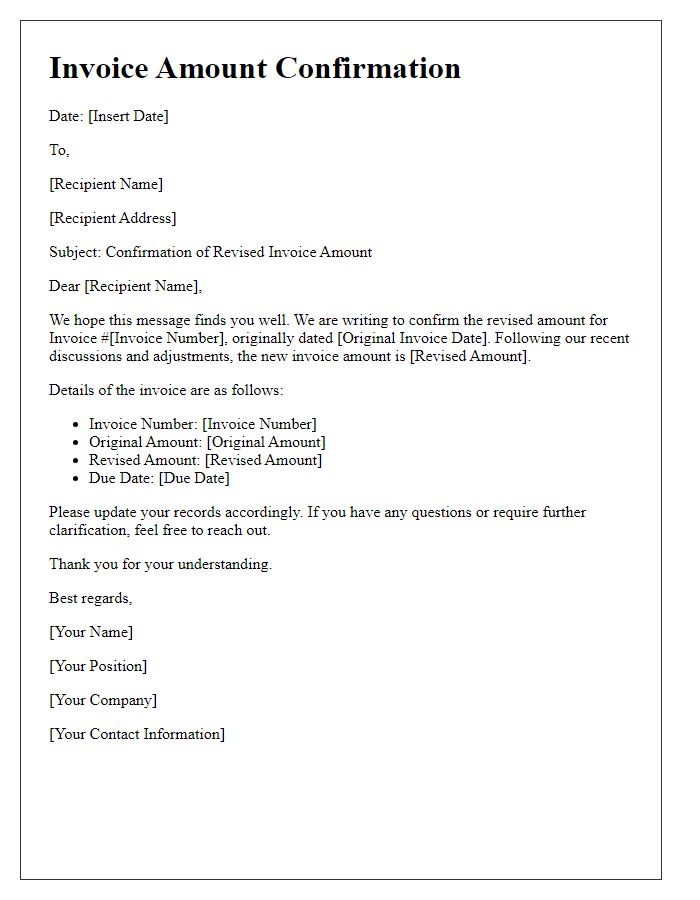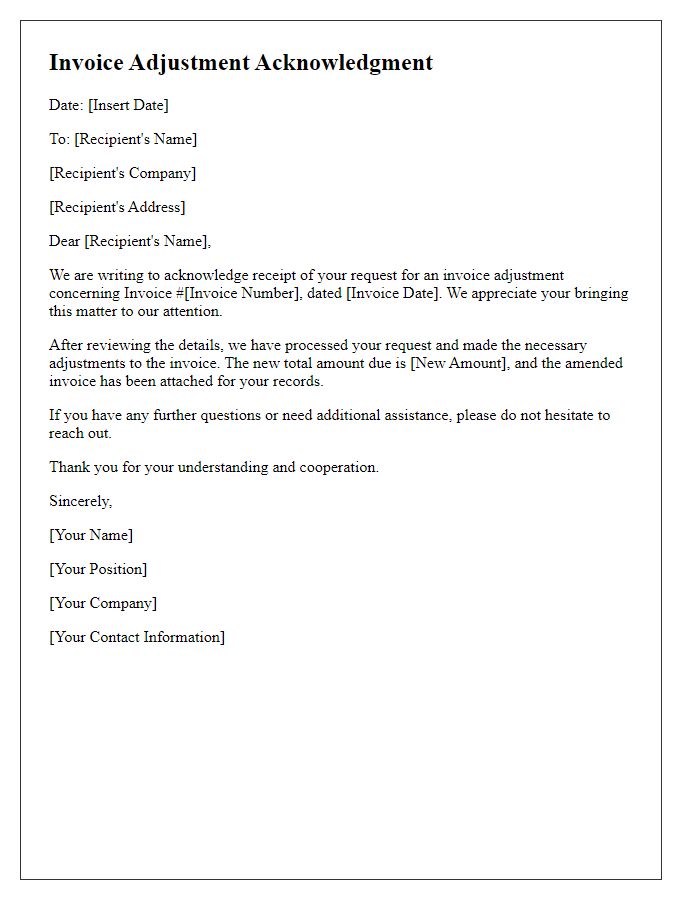Are you looking to streamline your financial communications? Confirmation letters for invoice adjustments are essential for maintaining clarity and professionalism in your business dealings. In this article, we'll explore how to craft a concise and effective letter that ensures both parties are on the same page regarding invoice amounts. Join us as we delve into the key elements of a well-structured confirmation letter to make your billing process seamless!

Subject Line and Header
The invoice amount adjustment confirmation reflects the accurate financial figures necessary for a seamless transaction. Details include the original invoice number, the revised total amount after adjustment, and the specific reasons for the change. The confirmation should indicate the date of adjustment and the provided contact information for inquiries, ensuring efficient communication between parties involved in the financial exchange. This document serves as a key reference point for both record-keeping and future audits within accounting systems.
Invoice Details and Reference Number
The invoice adjustment confirmation outlines the specifics of the amended amount for Invoice Number 12345, dated March 15, 2023. The initial amount was $1,000, which has been adjusted to $900 following the agreement reached during discussions on March 20, 2023. This adjustment has been documented in accordance with the payment terms outlined in the service contract (Contract Number ABC123) with XYZ Corporation. The revised total reflects an agreed discount of 10%, representing a savings of $100, and will be payable by the due date of April 30, 2023. The reference number for this adjustment is REF98765, ensuring accurate processing in your accounts payable system.
Explanation of Adjustment
Invoice adjustments often occur in business transactions due to various reasons, such as discrepancies in pricing, billing errors, or changes in service agreements. A common scenario involves adjusting the invoice amount for services rendered, like software development projects valued at $10,000, where clients may dispute certain charges due to unmet deliverables. Clear explanations identifying the reason for the adjustment, such as revising a previously quoted rate or rectifying a billing mistake, help maintain transparency. Documentation supporting the adjustment, including prior emails or amended contracts, bolsters credibility and ensures both parties have a mutual understanding of the financial arrangement moving forward. Proper communication about the adjustment process ensures continued trust and collaboration in future business dealings.
Confirmation of Updated Amount
An updated invoice amount confirmation is essential for maintaining clarity in financial transactions. When an invoice, originally totaling $2,500, is adjusted to $2,300, a formal confirmation is needed to document this change. This adjustment may stem from various factors, such as discount applications, pricing errors, or corrections of previously billed services. Clear communication regarding the updated amount ensures that both parties, including the service provider and the client, maintain mutual understanding and accurate financial records. Additionally, including the revised amount, invoice date, and any reference numbers aids in creating an organized financial audit trail.
Contact Information for Further Queries
Invoices often require adjustments for various reasons, like discrepancies in billing or changed project scope. An invoice adjustment, specifically the amount adjustment, ensures that the client is billed accurately based on the latest agreement. To confirm the recent adjustment in the invoice amount, stakeholders should reference documentation, such as the initial agreement dated January 10, 2023, or any subsequent communications about the changes made. For further queries regarding the adjusted invoice of $1,500, clients can reach out via email or phone to the accounting department, ensuring clarity and expediting resolution. Accurate communication regarding the invoice adjustments plays a pivotal role in maintaining a healthy client-business relationship.
Letter Template For Confirming Invoice Amount Adjustment. Samples
Letter template of confirming changes to invoice totals for record keeping.

Letter template of invoice amount modification acknowledgment for client.

Letter template of adjustment confirmation for invoice billing discrepancies.

Letter template of revised invoice amount confirmation for financial auditing.

Letter template of confirming updated invoice totals for payment processing.

Letter template of notification regarding invoice amount correction for compliance.

Letter template of acknowledgment for invoice adjustment request resolution.







Comments